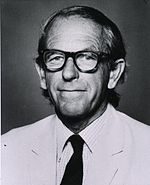- 1-Fluoro-2,4-dinitrobenzene
-
1-Fluoro-2,4-dinitrobenzene  1-fluoro-2,4-dinitrobenzeneOther namesDinitrofluorobenzene
1-fluoro-2,4-dinitrobenzeneOther namesDinitrofluorobenzeneIdentifiers Abbreviations DNFB CAS number 70-34-8 
PubChem 6264 ChemSpider 21106037 
UNII D241E059U6 
ChEBI CHEBI:53049 
ChEMBL CHEMBL167423 
Jmol-3D images Image 1 - O=[N+]([O-])c1cc(ccc1F)[N+]([O-])=O
Properties Molecular formula C6H3FN2O4 Molar mass 186.1 g mol−1 Appearance yellow crystals[1] Density 1.4718 g·cm−3 (54 °C)[2] Melting point 25.8 °C[2]
Boiling point 296 °C[2]
Hazards MSDS [1] EU classification  T
T (verify) (what is:
(verify) (what is:  /
/ ?)
?)
Except where noted otherwise, data are given for materials in their standard state (at 25 °C, 100 kPa)Infobox references 1-fluoro-2,4-dinitrobenzene, or Sanger's reagent (commonly called dinitrofluorobenzene or DNFB), is a chemical used for polypeptide sequencing.
Contents
Preparation
In 1936, Gottlieb presented a synthesis in which 1-chloro-2,4-dinitrobenzene reacted with potassium fluoride (KF) in nitrobenzene:[3]
Uses
In 1945, Frederick Sanger described its use for determining the N-terminal amino acid in polypeptide chains, in particular insulin.[4] Sanger's initial results suggested that insulin was a smaller molecule than previously estimated (molecular weight 12,000), and that it consisted of four chains (two ending in glycine and two ending in phenylalanine), with the chains cross-linked by disulfide bonds. Sanger continued work on insulin, using dinitrofluorobenzene in combination with other techniques, eventually resulted in the complete sequence of insulin (consisting of only two chains, with a molecular weight of 6,000).[5]
Following Sanger's initial report of the reagent, the dinitrofluorobenzene method was widely adopted for studying proteins, until it was superseded by other reagents for terminal analysis (e.g., dansyl chloride and later aminopeptidases and carboxypeptidases) and other general methods for sequence determination (e.g., Edman degradation).[5]
Dinitrofluorobenzene reacts with the amine group in amino acids to produce dinitrophenyl-amino acids. These DNP-amino acids are moderately stable under acid hydrolysis conditions that break peptide bonds. The DNP-amino acids can then be recovered, and the identity of those amino acids can be discovered through chromatography.
 Sanger's method of peptide end-group analysis: A derivatization of N-terminal end with Sanger's reagent (DNFB), B total acid hydrolysis of the dinitrophenyl peptide
Sanger's method of peptide end-group analysis: A derivatization of N-terminal end with Sanger's reagent (DNFB), B total acid hydrolysis of the dinitrophenyl peptide
See also
References
- ^ a b Oxford MSDS
- ^ a b c CRC Handbook of Chemistry and Physics, 90. edition, CRC Press, Boca Raton, Florida, 2009, ISBN 978-1-4200-9084-0, Section 3, Physical Constants of Organic Compounds, p. 3-260.
- ^ Hans Billroth Gottlieb: "The Replacement of Chlorine by Fluorine in Organic Compounds", J. Am. Chem. Soc., 1936, 58 (3), S. 532–533; doi:10.1021/ja01294a502.
- ^ Sanger, F (1945). "The free amino groups of insulin". The Biochemical journal 39 (5): 507–15. PMC 1258275. PMID 16747948. http://www.pubmedcentral.nih.gov/articlerender.fcgi?tool=pmcentrez&artid=1258275.
- ^ a b Joseph Fruton, Proteins, Enzymes, Genes: The Interplay of Chemistry and Biology. New Haven: Yale University Press, 1999. p. 216.
Literature
- T. Schaefer: "The Proton Magnetic Resonance Spectrum of 1-Fluoro-2,4-dinitrobenzene", Canadian Journal of Chemistry, 1961, 40, pp. 431–433; doi:10.1139/v62-068.
- B. D. Nageswara Rao: "The 1H and 19F Resonance Spectra of 1-Fluoro-2,4-dinitrobenzene", Molecular Physics, 1964, 7 (4), pp. 307–310; doi:10.1080/00268976300101071.
- A. Wilkins, R. W. H. Small: "Structure of 1-Fluoro-2,4-dinitrobenzene", Acta Cryst., 1991, C47, pp. 220–221; doi:10.1107/S0108270190007326.
External links
Categories:- Nitrobenzenes
- Organofluorides
Wikimedia Foundation. 2010.


